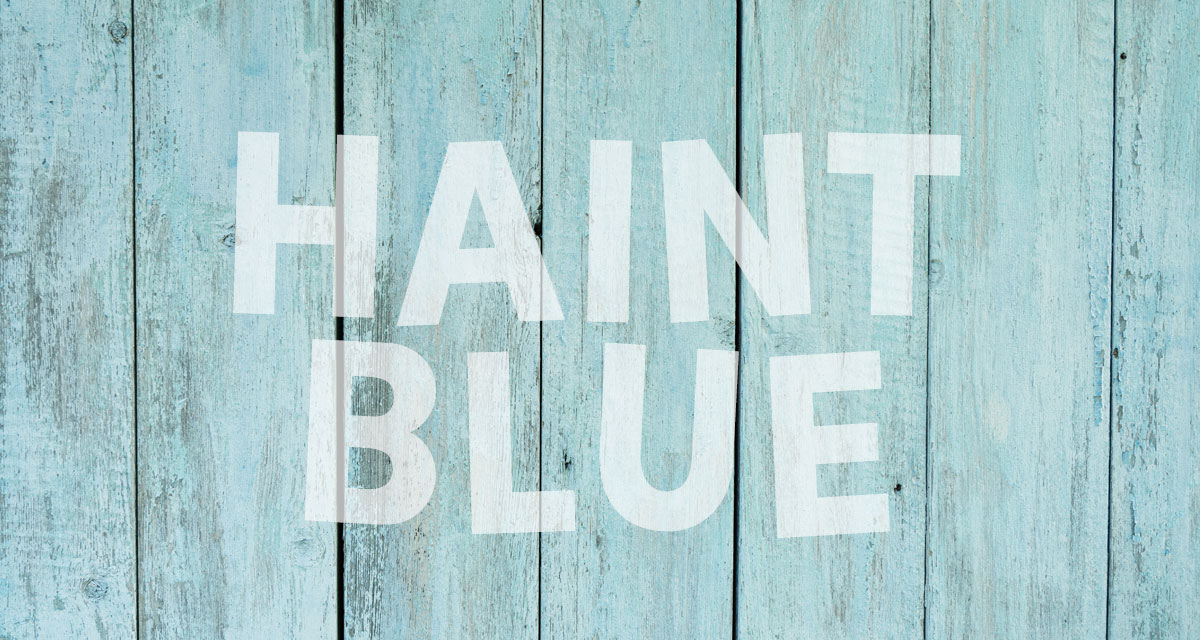Haints, Hot Steams, incantations, secret signs, had vanished with our years as mist with the sunrise. – To Kill a Mockingbird by Harper Lee
If you look up under the porches of the south, you’ll notice many outdoor porch ceilings are painted a shade of light blue. It’s not only a beautiful color, pleasing for porch sitting, the practice has a long history rich with cultural importance, as well.
Most historians attribute blue porch ceilings to the traditions of the Gullah Geechee people who were descendants of Africans enslaved on cotton, rice and indigo plantations of South Carolina, Georgia and Florida. Through the centuries, Gullah Geechee language, culture and traditions, including the use of “haint blue” developed from a blending of Central and West African ethnic groups.
What is a haint?
It’s possible the name haint was derived from the word “haunt,” but it has its own meaning and complicated cultural context. A haint is a restless ghost who has not left the world but has remained behind to haunt the living with trickery that is often harmless, but sometimes more menacing in nature. The lore of the haints in the U.S. can be traced back to the low country – a 200-mile area of coastal South Carolina and Georgia.
Gullah folklore tells us that ghosts, also referred to as haints, were not able to cross water. So, in order to prevent evil spirits from coming into homes, porch ceilings were painted a soft blue. The color was meant to simulate water in an effort to keep any haints or spirits at bay. To make the blue paint, the Gullah people combined milk, indigo dye, lime and other pigments. Many also believed the blue paint acted as a bug repellent because of the lime in the mixture, which can be a natural insect deterrent.
Some took it a step further and painted doors and window frames haint blue. The thinking was that haints would assume the door and windows were the sky, and therefore, get totally confused about how to enter the home.
The power of indigo.
The indigo (Indigofera tinctoria) plant is the natural source of the bold blue color that’s been prized for centuries across many cultures for its spiritual power and as a symbol of wealth. It was so valuable it earned the name “blue gold,” mostly due to the specific and strenuous processes necessary to extract the dye from the indigo plant. The cultivation practices were used by numerous ancient civilizations and date back five centuries in parts of Africa.
In a terribly ironic twist, this blue dye itself contributed to the suffering of the Gullah people. True indigo, a bean plant that provided valuable blue dye in early American history, was among the most important cash crops in the south, just behind cotton and tobacco, and its value helped strengthen and perpetuate the slave trade. The color once believed to protect the African people from the dreaded haints added to their misery in the antebellum south.
What started as superstition has become a design trend over the years. Porch ceilings are now painted blue all across the south and beyond, because it’s a custom and because many remember their grandparents’ or great-grandparents’ blue porch ceilings. In some cases, people chose to paint their porches this lovely light blue just because they like it. Even in design circles, the pale blue-green tint is now known as “haint blue.”
Whatever the real reasons behind this color being used for porch ceilings, the practice spread from a folk belief of enslaved Gullah people to one that southerners of all races employed in their own homes.



















